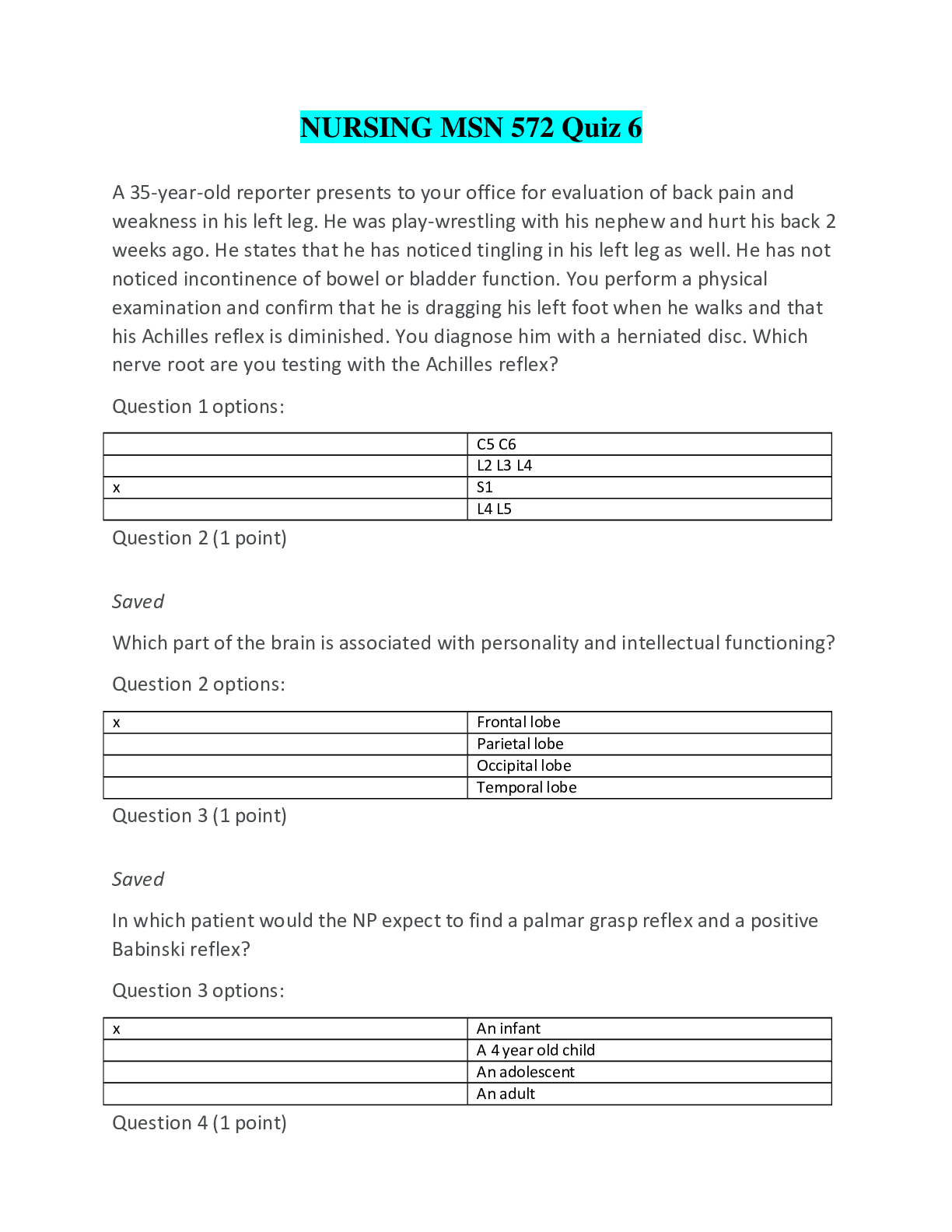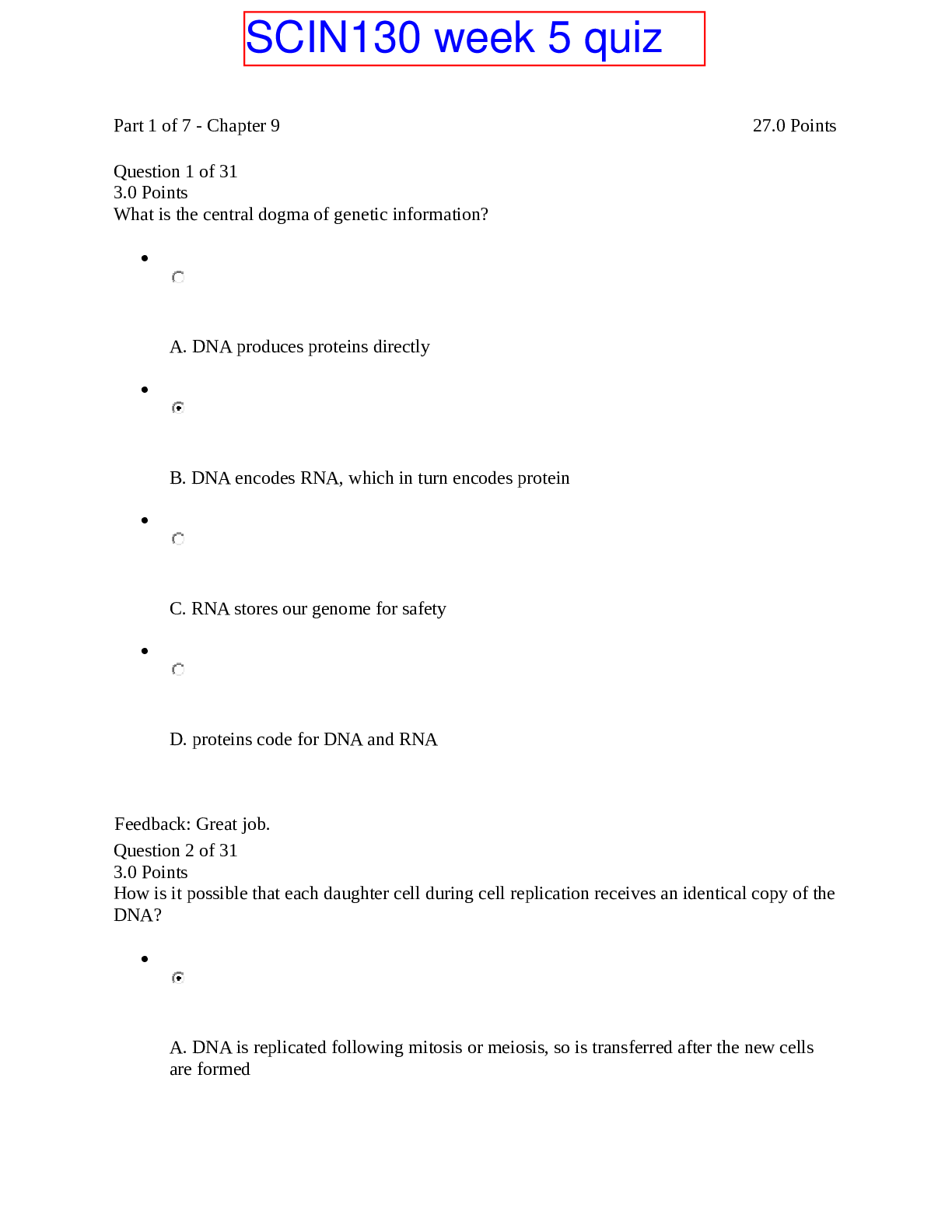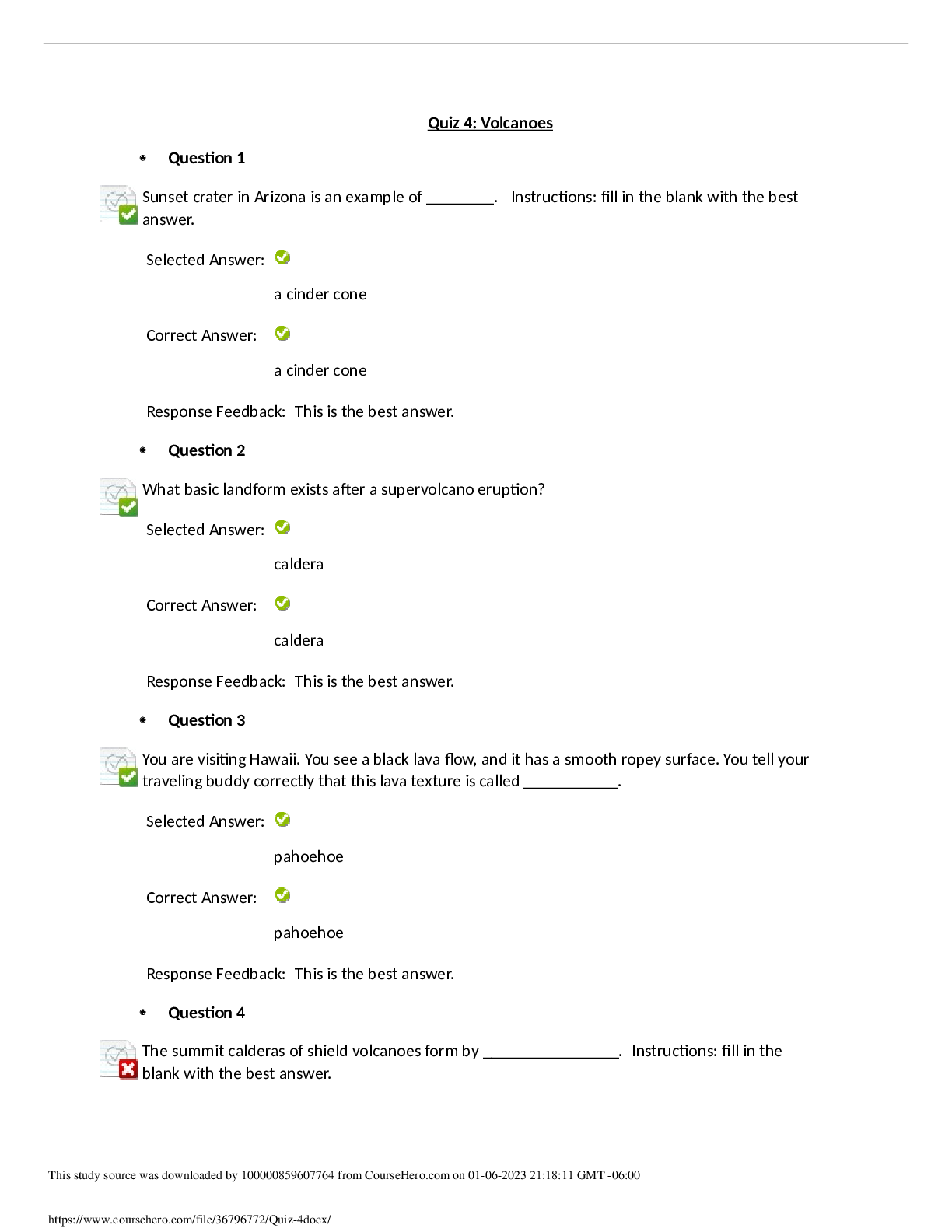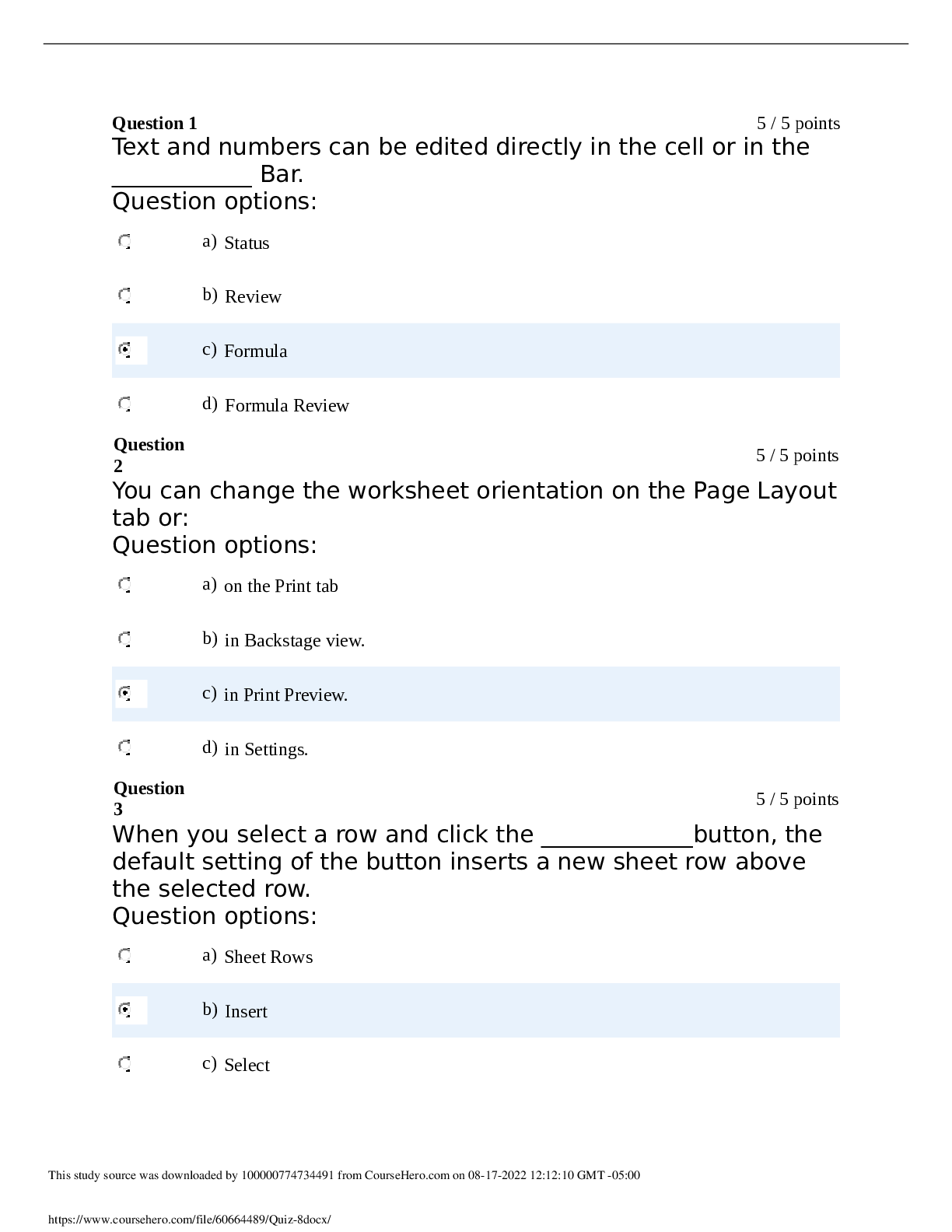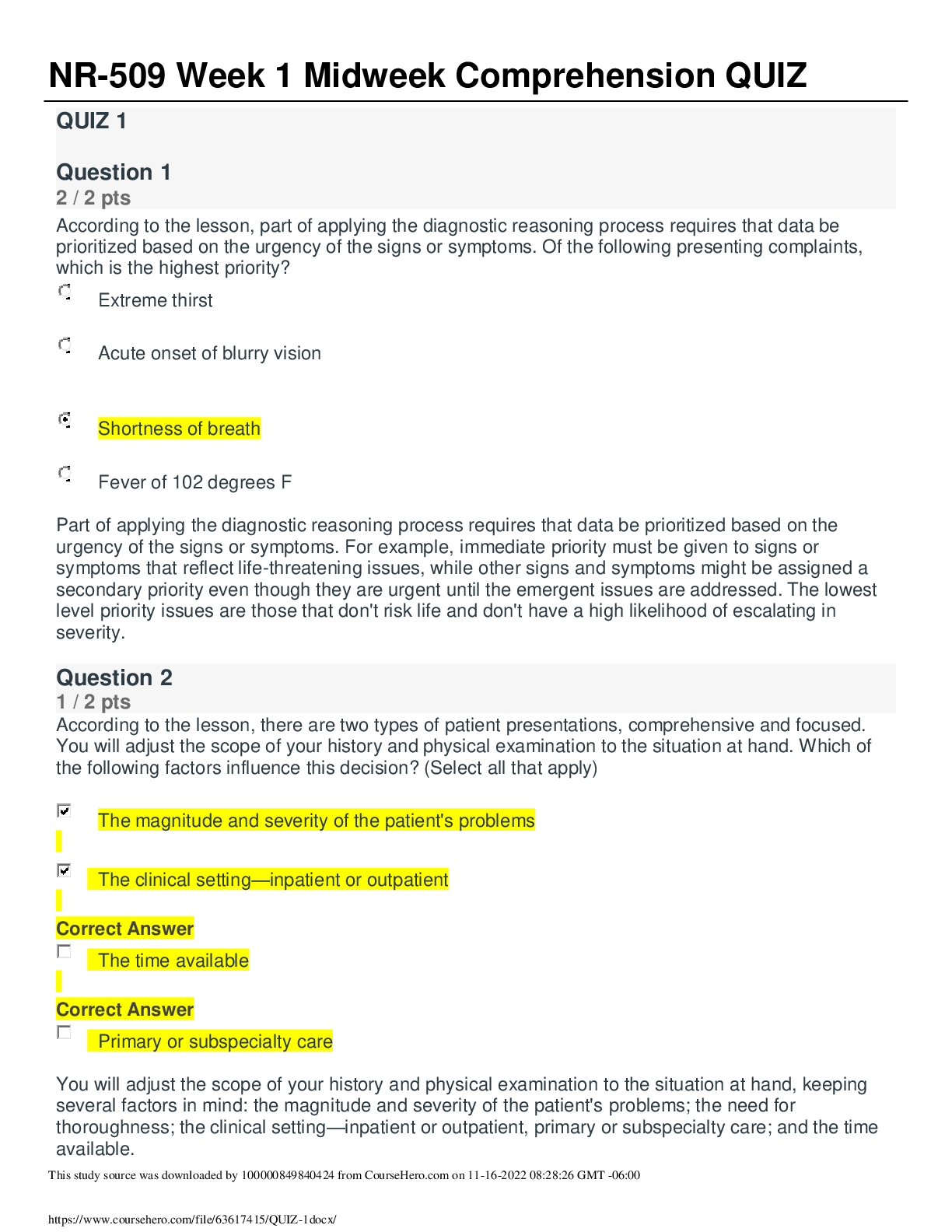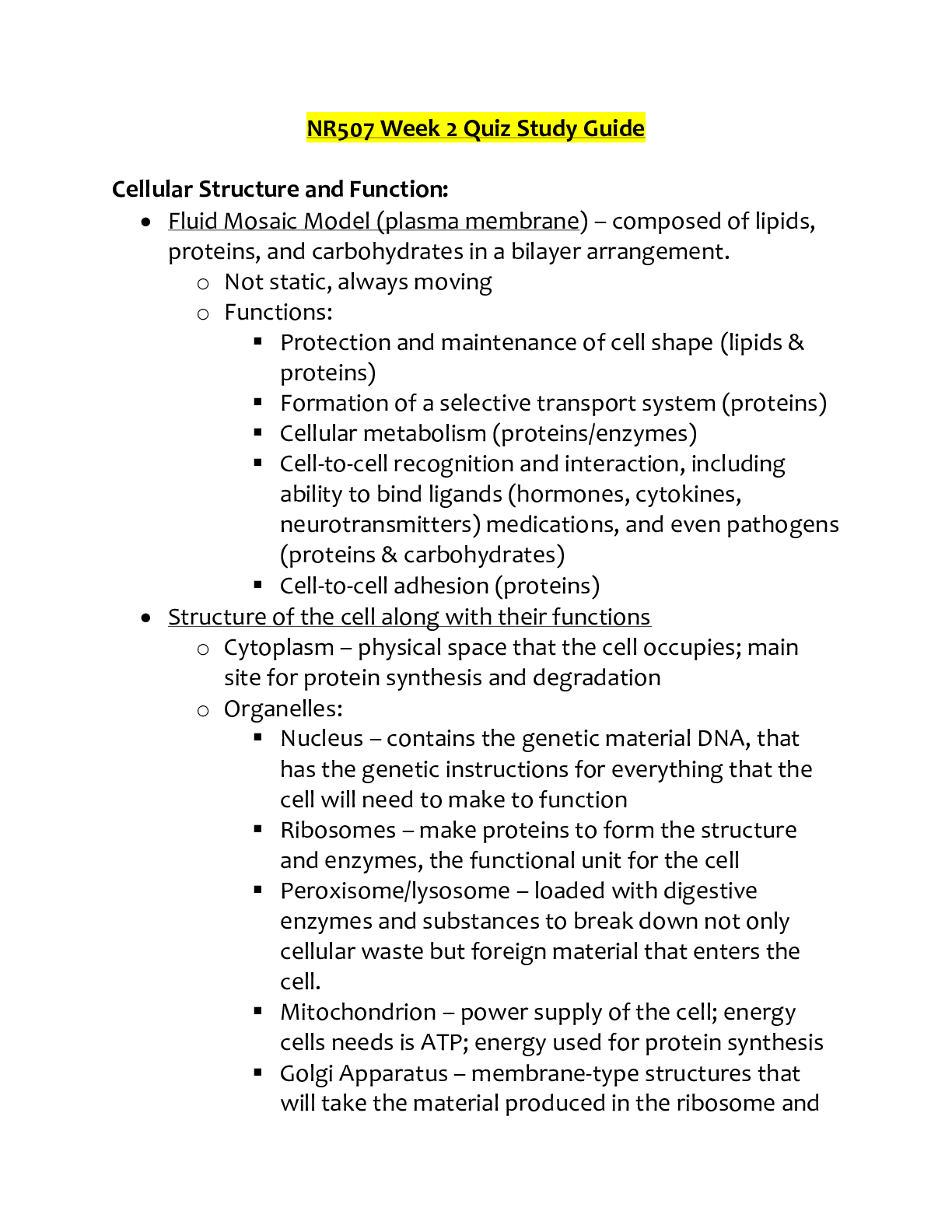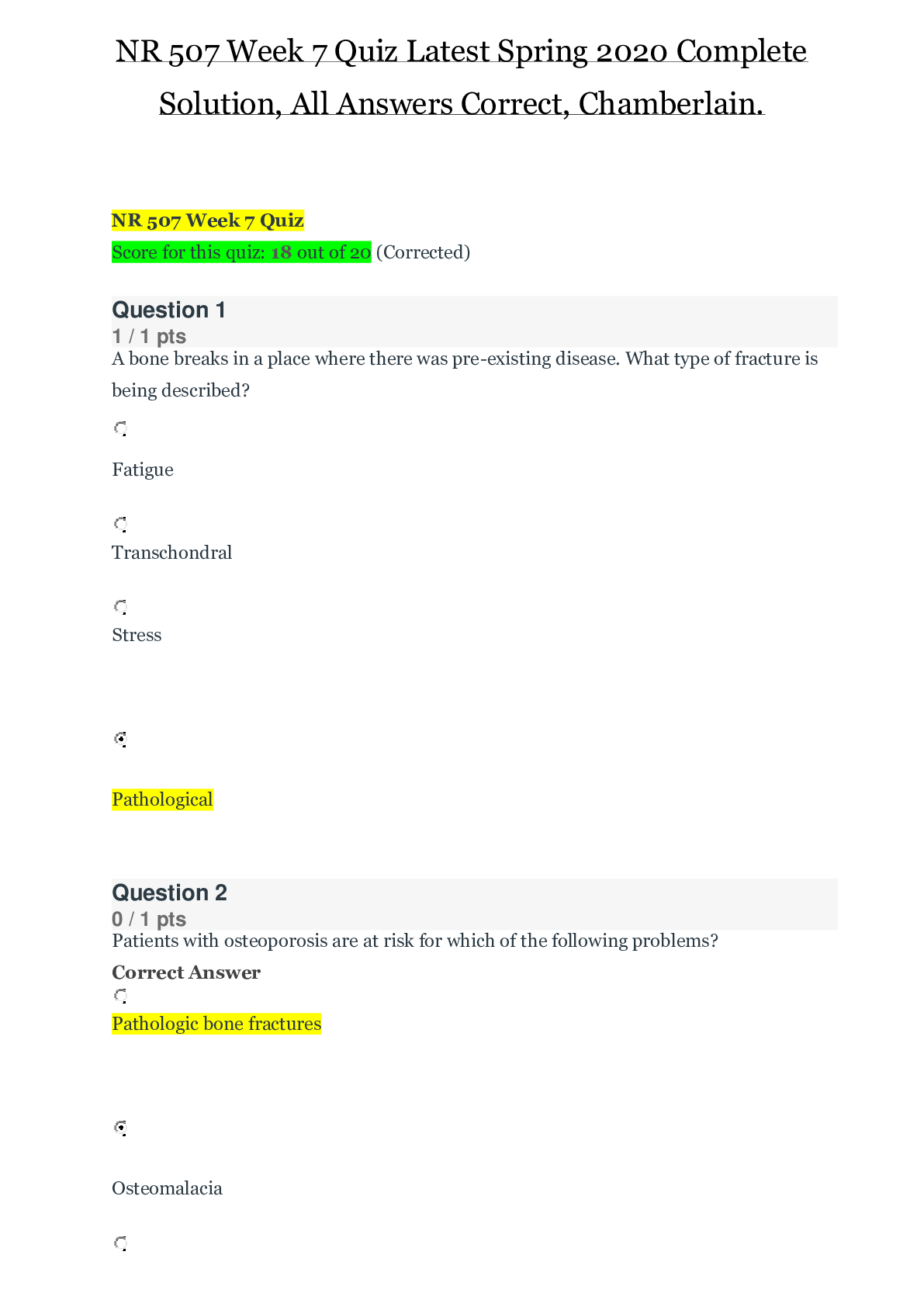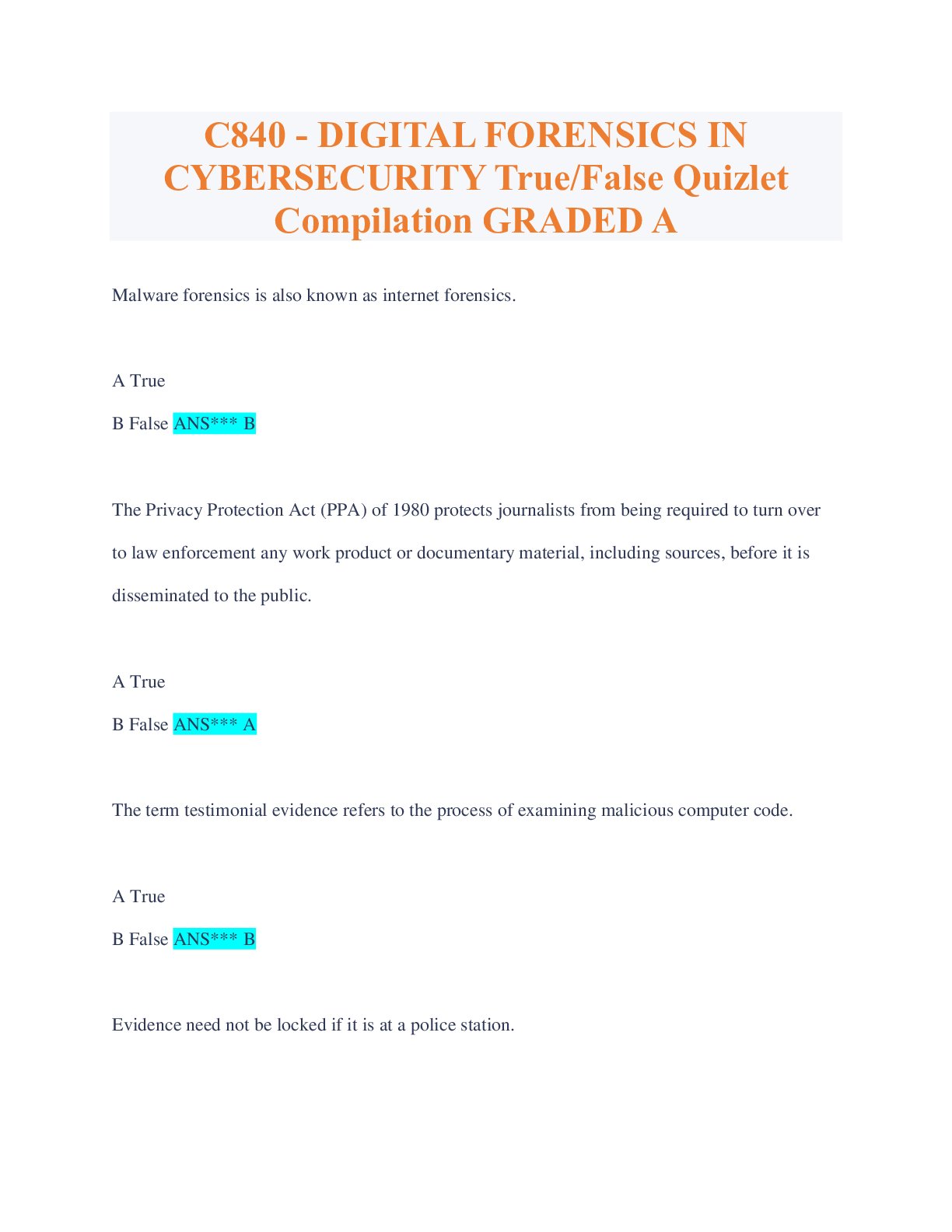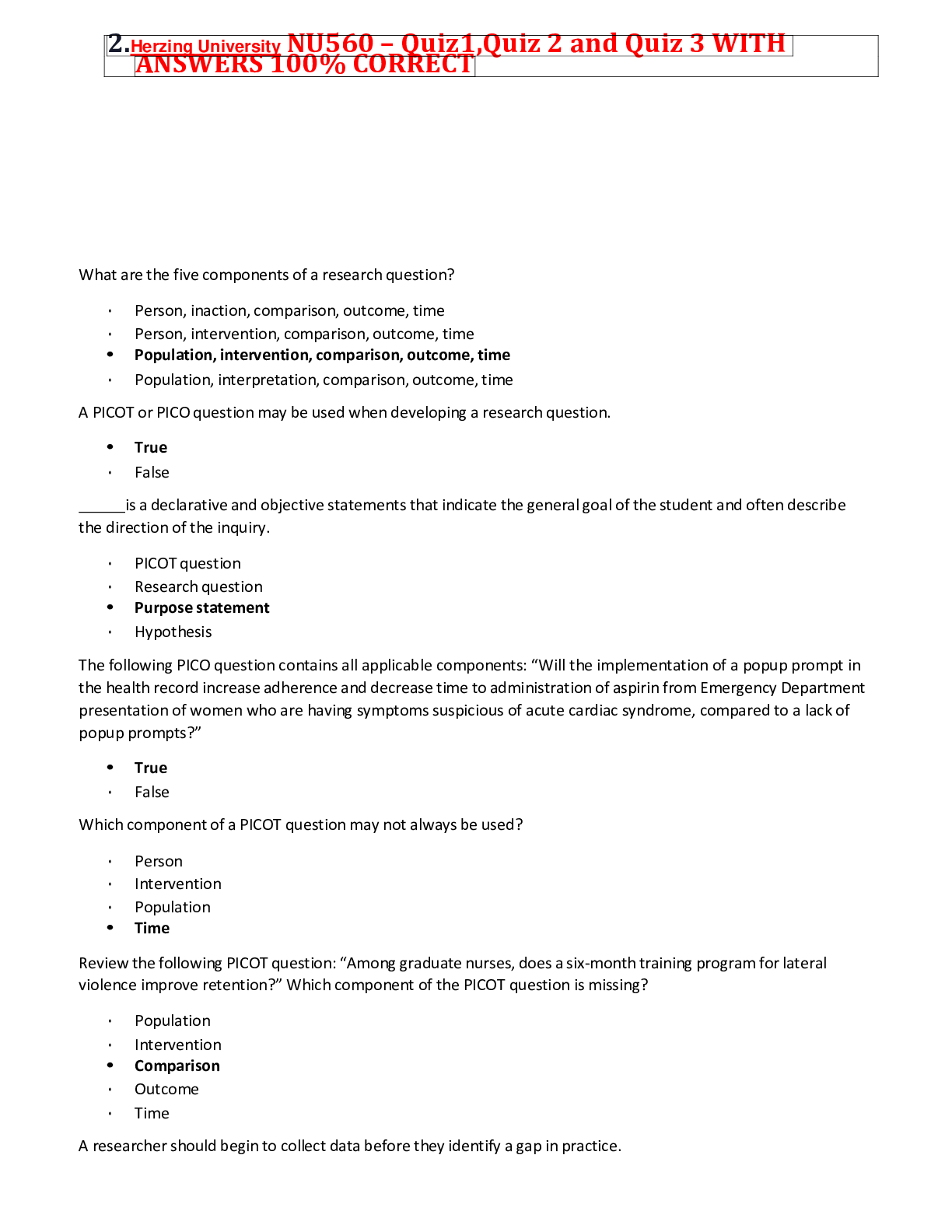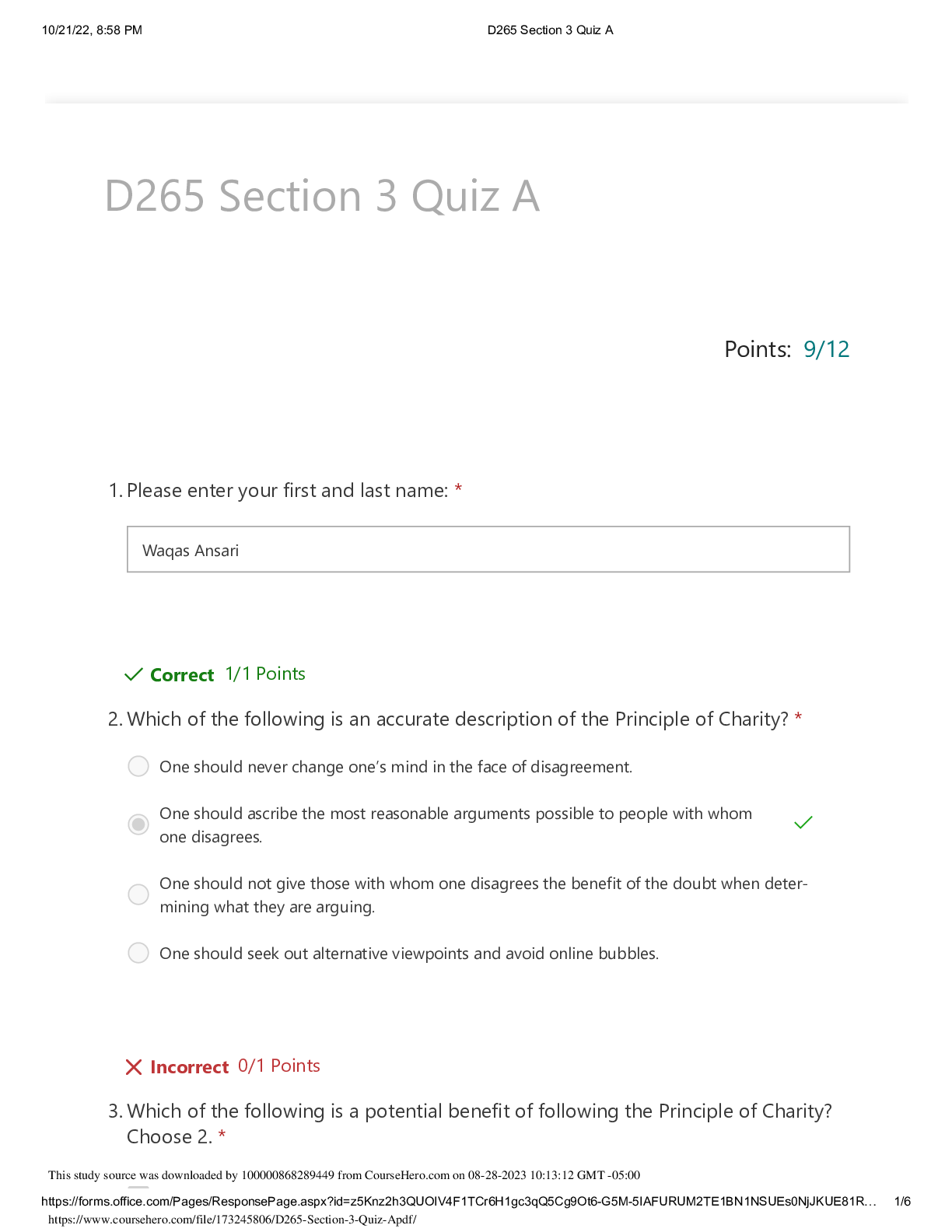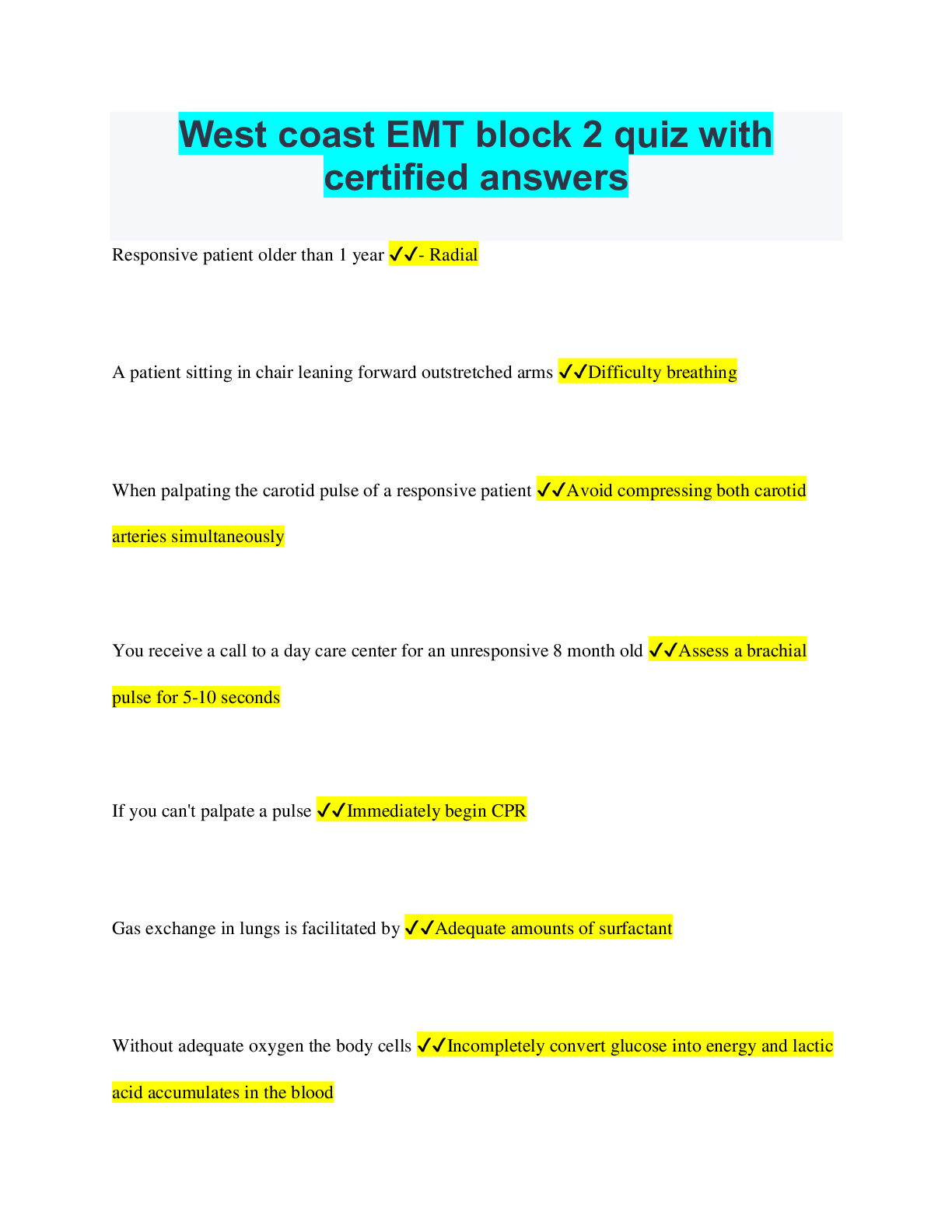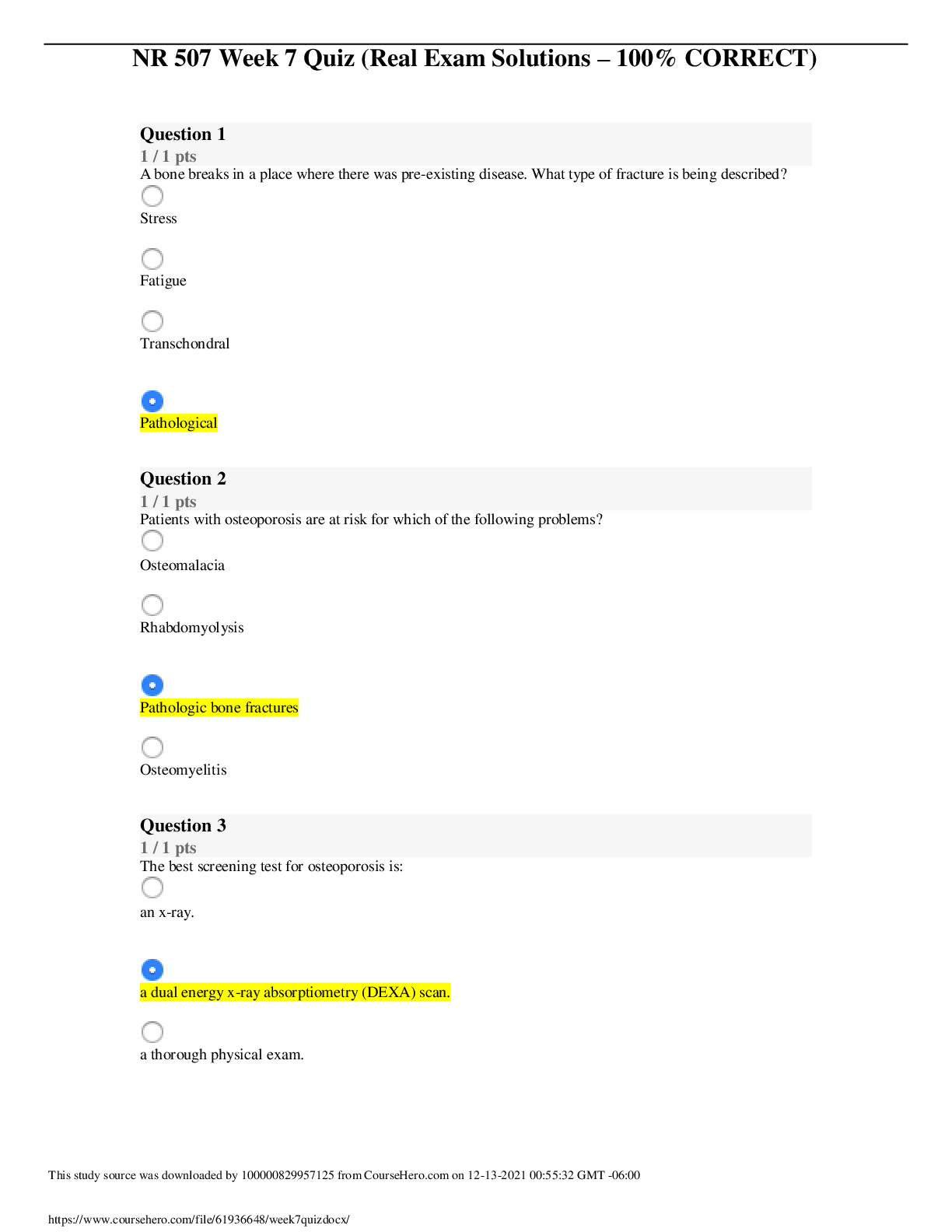American Military University SCIN 130 Week 1 Quiz. All 31 QnA Score 100%.
Document Content and Description Below
Part 1 of 7 - Part 1: Text Material 27.0 Points Question 1 of 31 3.0 Points Which is a single cell that lacks membrane bound organelles? A. Ribosomes B. Eukaryote C. Nucleolus �... � D. Prokaryote Feedback: Great. Question 2 of 31 3.0 Points What is the term for an organisms' ability to maintain constant internal conditions even when environmental conditions change? A. Centered B. Homeostasis C. Equilibrium D. Equality Feedback: Great. Question 3 of 31 3.0 Points Which statement would be a hypothesis using the scientific method? A. There must be something wrong with my sprinkler. B. My grass is not growing. C. If my sprinklers are not working, then my flowers will also die. D. Why isn’t my grass growing? E. I turn on my sprinklers. Feedback: Remember, the hypothesis works to answer your question, and a prediction is based on the hypothesis, so they may sound similar. Review the scientific process in Chapter 1. Question 4 of 31 3.0 Points What is the first step in the scientific process? A. Observation B. Data collection C. Hypothesis formation D. PredictionFeedback: Great job. Question 5 of 31 3.0 Points What is the correct order from highest level to lowest level of taxonomic hierarchy? A. Order, family, genus, species B. Genus, species, order, family C. Species, genus, family, order D. Family, order, genus, species Feedback: Great. Question 6 of 31 3.0 Points What is adaptation due to? A. altering reproduction from single to multi-cell B. a change in eating habits due to health issues C. response to touching a thorn on a plant D. a consequence of evolution by natural selection Feedback: All living organisms share several key characteristics that define life; adaptation is one of them. For more information, see properties of life in Chapter 1. Question 7 of 31 3.0 Points What process do scientists use as a way to perform research with defined steps that include experiments and careful observation? A. A clean lab bench B. A journal article C. The scientific method D. The right hypothesis Feedback: Great job. Question 8 of 31 3.0 Points What is a good basic definition of biology? A. The science that studies rocks. B. The science that studies chemicals. C. The science that studies life. D. The science that studies art. E. The science that studies death. Feedback: Great. Question 9 of 31 3.0 Points What is the main reason offspring will belong to the same species as the parents? A. They share the same genes. B. They share the same habitat. C. They share the same food. D. They share the same environment. Feedback: Great. Part 2 of 7 - Part 1: Text Material - B 27.0 Points Question 10 of 31 3.0 Points What did the modern synthesis add to the theories of Darwin and Wallace? A. A framework for understanding limited resources. B. The concept of natural selection. C. A modern understanding of cellular respiration. D. Mechanisms of inheritance of traits. Feedback: Darwin and Wallace proposed the process of natural selection but did not understand how traits are inherited. Read more in Chapter 11. Question 11 of 31 3.0 Points Homologous structures: A. result from divergent evolution. B. are a result of the bottleneck effect. C. occur in unrelated species. D. evolve from a common ancestor. Feedback: Great job. Question 12 of 31 3.0 Points Which statement best describes analogous structures? A. occur in unrelated species B. cause increased mutation C. result from divergent evolution D. evolve from a common ancestorFeedback: Great job. Question 13 of 31 3.0 Points What is an example of gene flow? A. Purple alleles result in allopatric speciation. B. A new purple allele arises in the population by mutation. C. In a population flowers that carry purple alleles are pollinated more often. D. Purple alleles are introduced into population by migration. Feedback: Review Chapter 11. Question 14 of 31 3.0 Points What is the change in a population’s allele frequency from one generation to the next that is due to chance known as? A. natural selection B. migration C. genetic drift D. mutation Feedback: Great job. Question 15 of 31 3.0 Points When does allopatric speciation occur? A. when mutation increases the number of offspring. B. when individual migrate from one population to another C. when populations are geographically separated and diverge. D. when a parent species becomes two species in one location. Feedback: Great job. Question 16 of 31 3.0 Points What is one of the three principles that results in natural selection? A. Resources are unlimited and arise from the endless supply of energy from the sun. B. Characteristics are inherited from parent to offspring. C. Inheritance of acquired characteristics creates a strong evolutionary force. D. Individuals in a population have the same ability to survive and reproduce. Feedback: Inheritance of characteristics that increase survival and/or reproduction in an environment with limited resources results in natural selection. Read more in Chapter 11. Question 17 of 31 3.0 Points Which of the following is correct? A. Evolution is widely accepted based on scientific data and evidence. B. One important fact of evolution is that organisms evolve on purpose. C. Evolution is a just a theory that has little evidence to support it D. Since evolution occurred in the past it cannot be studied scientifically. Feedback: Great job. Question 18 of 31 3.0 Points What is a vestigial structure? A. A physical characteristic that does not have a function but does have a function in ancestral species. B. A trait that results from a particular type of mutation during development. C. An analogous characteristic that is similar between unrelated species. D. An anatomical trait that changes during development from small to large. Feedback: Vestigial structures are an evidence of evolution. Read more in Chapter 11. Part 3 of 7 - Part 2: Lecture 9.0 Points Question 19 of 31 3.0 Points It is important to understand issues of the modern world but separating what in current literature? A. Interesting articles and boring articles B. Television shows and magic C. Valid science and pseudoscience D. News articles and social media Feedback: Great job. Question 20 of 31 3.0 Points A molecular biologist notices something different in the genetic profile of an individual, performs careful research, and thinks he discovers a new gene responsible for high blood pressure in humans. The last step is an example of what part of the scientific method? A. Observation B. Conclusion C. Question D. Experiment E. Hypothesis Feedback: The first step in an experiment is noticing an anomaly or something interesting,building on that with a question and hypothesis, and designing an experiment based on that – finally reaching the end with your conclusions. See What Is Biology Built On in the Lesson Lecture. Question 21 of 31 3.0 Points Malaria acts as a natural selective agent so that people with what disorder have a survival advantage? A. Fragile X Syndrome B. Down Syndrome C. Hemophilia D. Thalassemia E. Sickle Cell Anemia F. Cystic FibrosisFeedback: Great job. Part 4 of 7 - Part 3: Lab 9.0 Points Question 22 of 31 3.0 Points Science relies on all of the following EXCEPT __________. A. Facts B. Logic C. Bias D. Data E. Analysis Feedback: Correct! The scientific method relies on fact-based, observable and objective measurements, data and interpretation. Review the various components of “science” from the Week 1 Lab ELF Lesson. Question 23 of 313.0 Points Which of the following principles is important to drawing scientific conclusions? A. Imprecision B. Opinion C. Subjectivity D. Bias E. Repeatability Feedback: Correct! Conclusions about scientific phenomena can be drawn when multiple scientists can reliably repeat the same observations or outcomes to their hypotheses. Question 24 of 31 3.0 Points Which scientist contributed to the study of geology by studying the movement of glaciers? A. Louis Agassiz B. James Hutton C. Christian Doppler D. Charles Darwin E. Gregor Mendel Feedback: Correct! This scientist studied glaciation, and his observations led to the discovery of historic ice ages. Part 5 of 7 - Lab Material 15.0 Points Question 25 of 31 3.0 Points Why should we study elephants? A. They drink so much water, we don’t want to run out. B. They are big, but not important. C. They are invading the local urban areas. D. They are a keystone species. Feedback: Great. Question 26 of 31 3.0 Points Which survey method for elephant counts was an indirect type? A. Individual range B. Individual registration C. Species range D. Dung transects E. Aerial survey Feedback: Great. Question 27 of 31 3.0 Points Which survey method for elephant counts was a sample or direct type? A. Dung transects B. Individual range C. Species range D. Acoustic survey E. Aerial survey F. Individual registration Feedback: Great. Question 28 of 31 3.0 Points Which survey method for elephant counts was a total type? A. Individual registration B. Species range C. Aerial survey D. Individual range E. Acoustic survey F. Dung transects Feedback: Great. Question 29 of 31 3.0 Points As mentioned in the lab, in addition to poaching, why have elephant populations been decreasing over the last few years? A. Food Shortage B. Habitat Loss C. Climate Change D. Water IssuesFeedback: Great. Part 6 of 7 - Lab Essay 5.0 Points Question 30 of 31 5.0 Points In a few sentences, what was the overall purpose of the lab for this week? You should include 1- 2 sentences on the methods and then the overall reason. The purpose of the lab for this week was to analyze data to get us familiar with the process. Throughout the lab I learned a lot about elephants that I didn't preciously know. Comment: Hi Shelbi, The purpose of the lab this week was to explore the scientific method. Elephants were used as the example. Part 7 of 7 - Lab Upload 8.0 Points Question 31 of 31 8.0 Points Please upload your completed Lab Packet for this week. Make sure your name is on the top in .. [Show More]
Last updated: 1 year ago
Preview 1 out of 24 pages
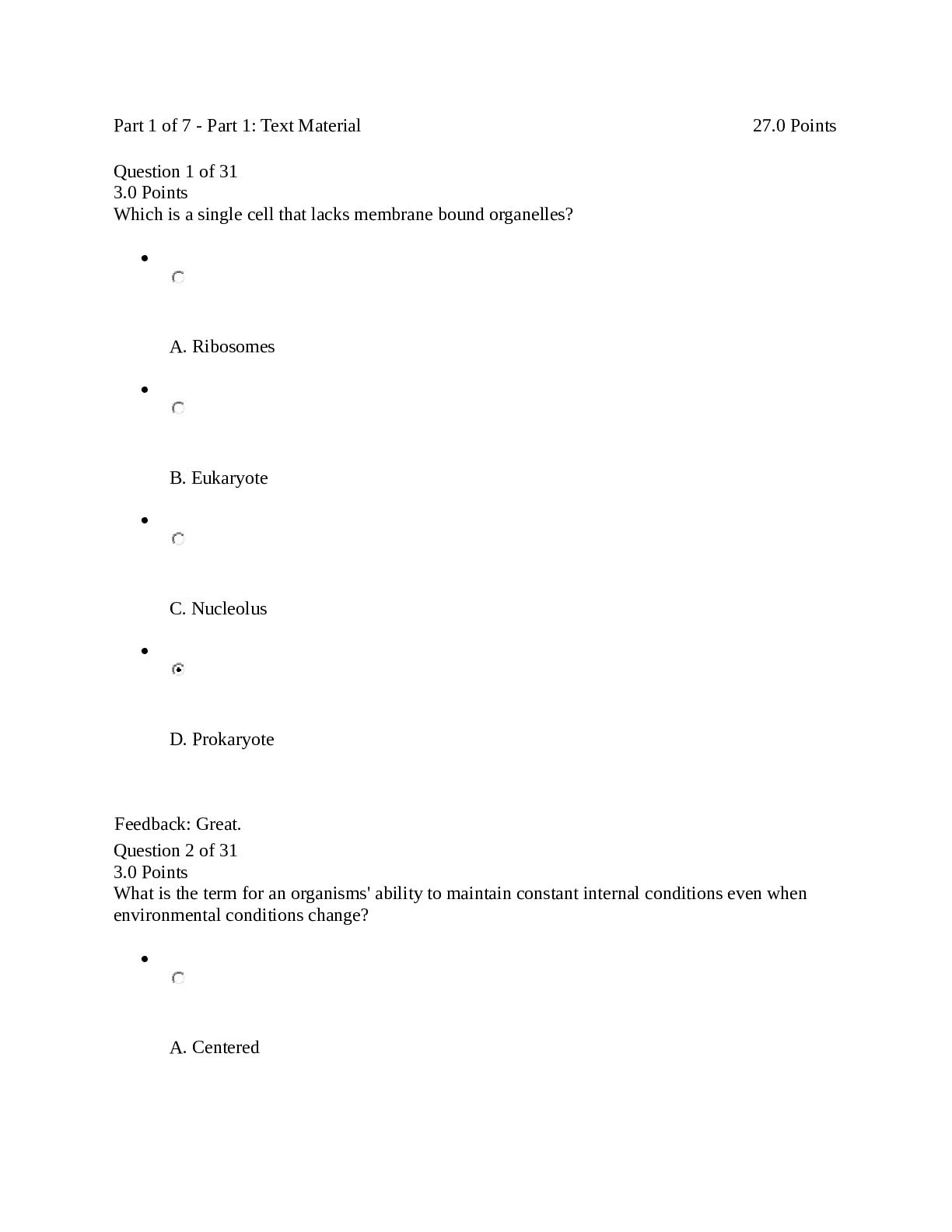
Reviews( 0 )
Document information
Connected school, study & course
About the document
Uploaded On
May 02, 2022
Number of pages
24
Written in
Additional information
This document has been written for:
Uploaded
May 02, 2022
Downloads
0
Views
76

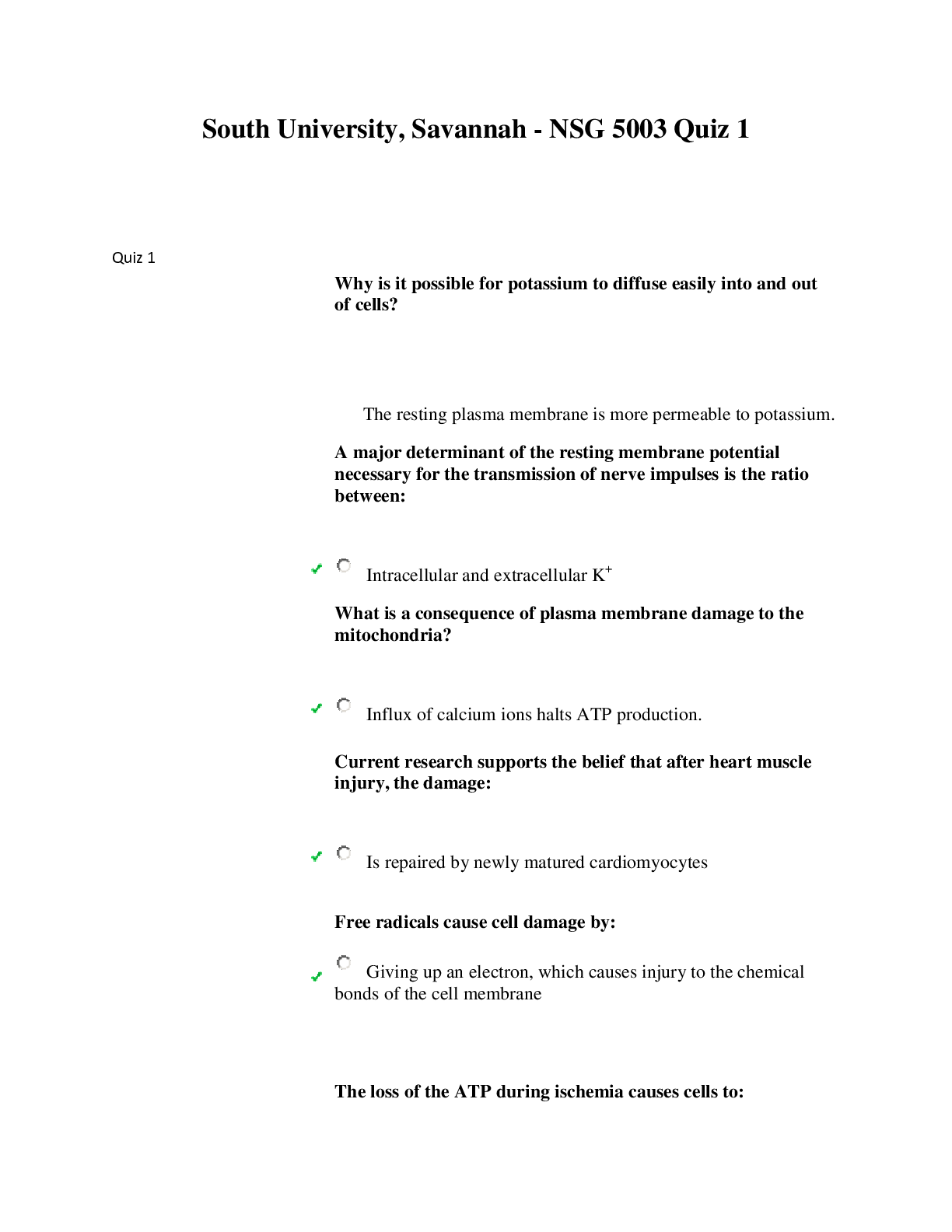
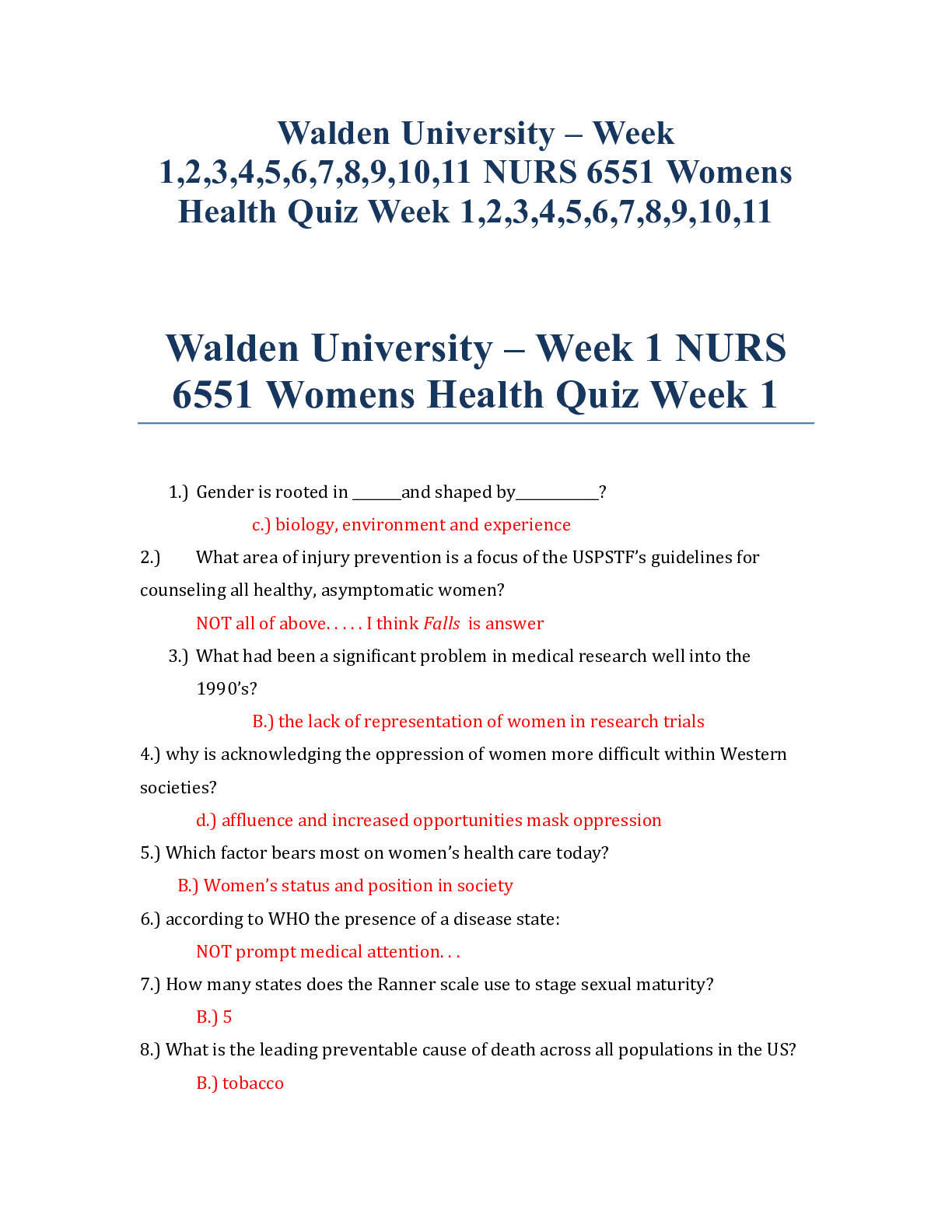


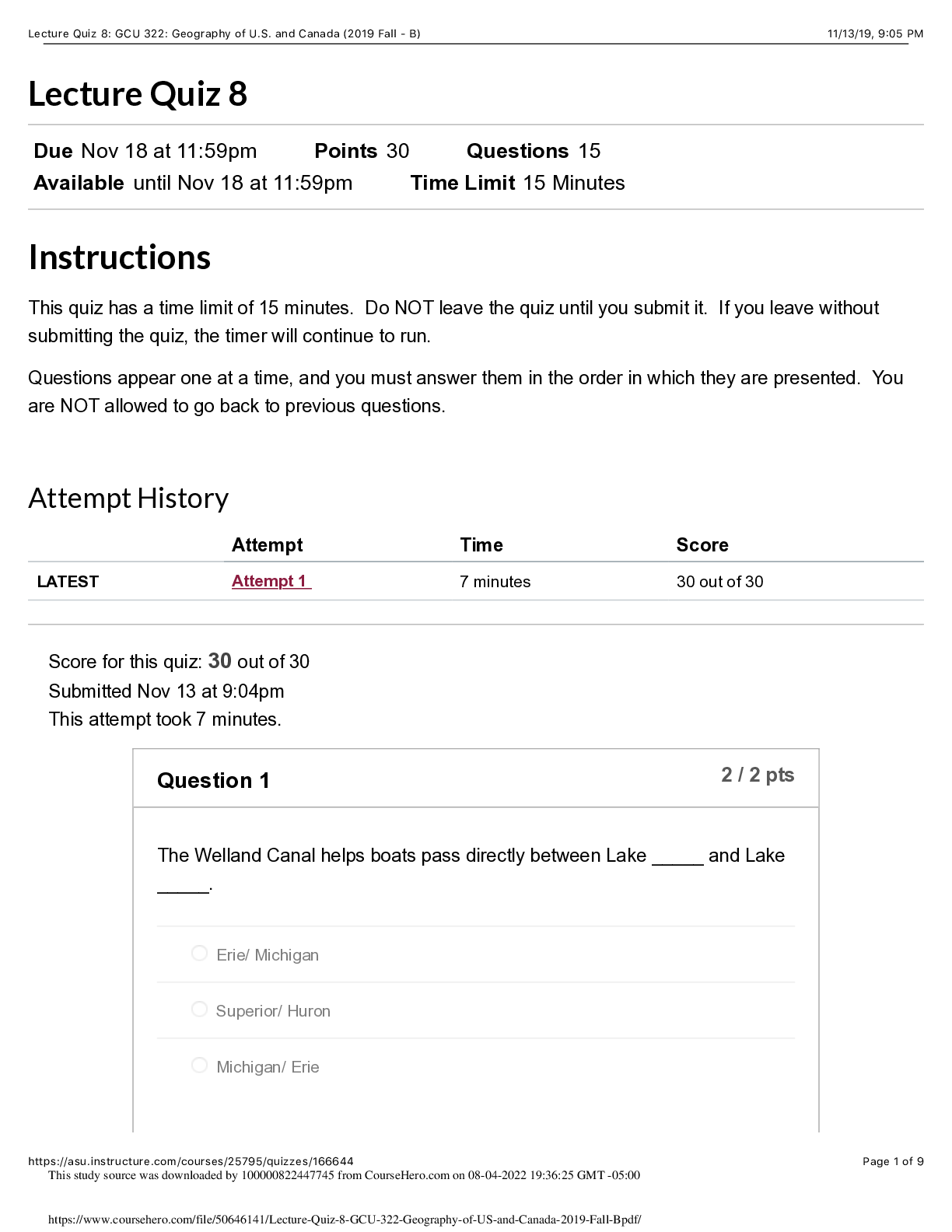

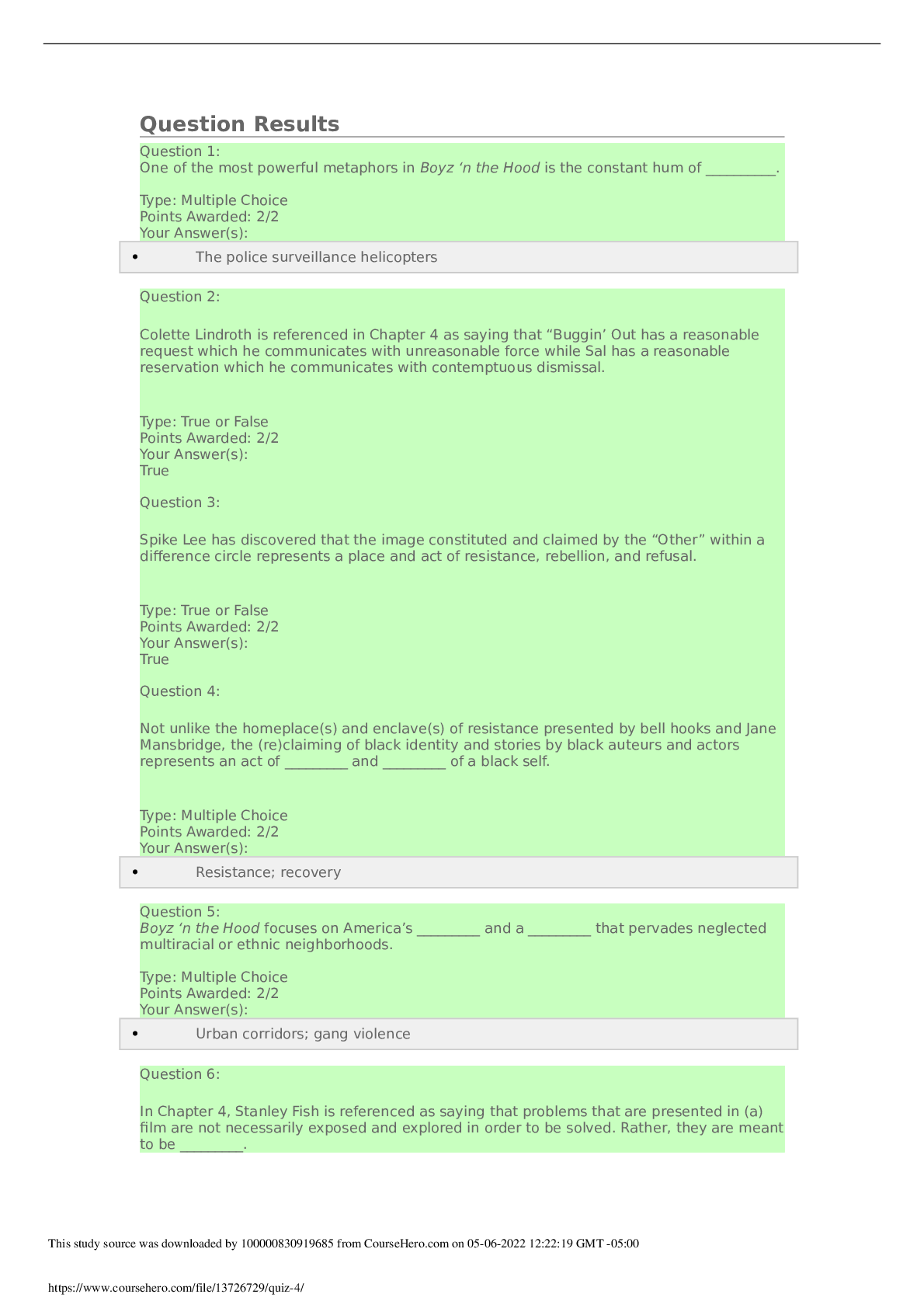
.png)



